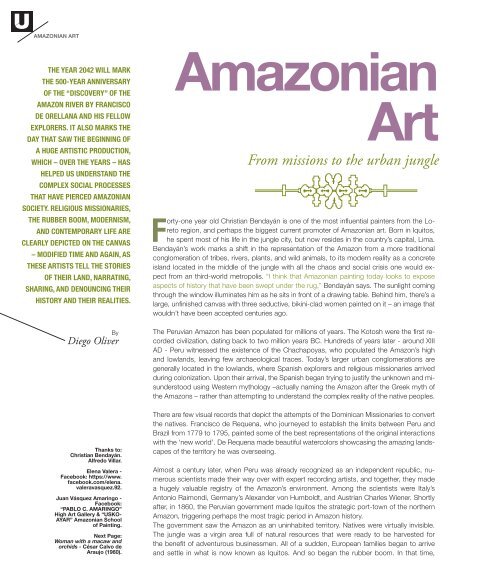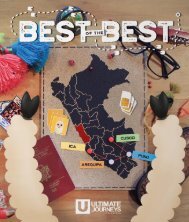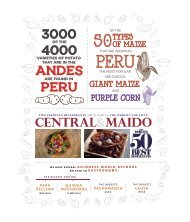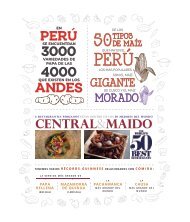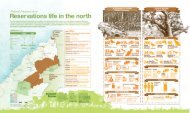UJ #7 - Peruvian Amazon
You also want an ePaper? Increase the reach of your titles
YUMPU automatically turns print PDFs into web optimized ePapers that Google loves.
AMAZONIAN ART<br />
THE YEAR 2042 WILL MARK<br />
THE 500-YEAR ANNIVERSARY<br />
OF THE “DISCOVERY” OF THE<br />
AMAZON RIVER BY FRANCISCO<br />
DE ORELLANA AND HIS FELLOW<br />
EXPLORERS. IT ALSO MARKS THE<br />
DAY THAT SAW THE BEGINNING OF<br />
A HUGE ARTISTIC PRODUCTION,<br />
WHICH – OVER THE YEARS – HAS<br />
HELPED US UNDERSTAND THE<br />
COMPLEX SOCIAL PROCESSES<br />
THAT HAVE PIERCED AMAZONIAN<br />
SOCIETY. RELIGIOUS MISSIONARIES,<br />
THE RUBBER BOOM, MODERNISM,<br />
AND CONTEMPORARY LIFE ARE<br />
CLEARLY DEPICTED ON THE CANVAS<br />
– MODIFIED TIME AND AGAIN, AS<br />
THESE ARTISTS TELL THE STORIES<br />
OF THEIR LAND, NARRATING,<br />
SHARING, AND DENOUNCING THEIR<br />
HISTORY AND THEIR REALITIES.<br />
By<br />
Diego Oliver<br />
Thanks to:<br />
Christian Bendayán.<br />
Alfredo Villar.<br />
Elena Valera -<br />
Facebook: https://www.<br />
facebook.com/elena.<br />
valeravasquez.92.<br />
Juan Vásquez Amaringo -<br />
Facebook:<br />
“PABLO C. AMARINGOˮ<br />
High Art Gallery & “USKO-<br />
AYARˮ <strong>Amazon</strong>ian School<br />
of Painting.<br />
Next Page:<br />
Woman with a macaw and<br />
orchids - César Calvo de<br />
Araujo (1960).<br />
<strong>Amazon</strong>ian<br />
Art<br />
From missions to the urban jungle<br />
Forty-one year old Christian Bendayán is one of the most influential painters from the Loreto<br />
region, and perhaps the biggest current promoter of <strong>Amazon</strong>ian art. Born in Iquitos,<br />
he spent most of his life in the jungle city, but now resides in the country’s capital, Lima.<br />
Bendayán’s work marks a shift in the representation of the <strong>Amazon</strong> from a more traditional<br />
conglomeration of tribes, rivers, plants, and wild animals, to its modern reality as a concrete<br />
island located in the middle of the jungle with all the chaos and social crisis one would expect<br />
from an third-world metropolis. “I think that <strong>Amazon</strong>ian painting today looks to expose<br />
aspects of history that have been swept under the rug,” Bendayán says. The sunlight coming<br />
through the window illuminates him as he sits in front of a drawing table. Behind him, there’s a<br />
large, unfinished canvas with three seductive, bikini-clad women painted on it – an image that<br />
wouldn’t have been accepted centuries ago.<br />
The <strong>Peruvian</strong> <strong>Amazon</strong> has been populated for millions of years. The Kotosh were the first recorded<br />
civilization, dating back to two million years BC. Hundreds of years later - around XIII<br />
AD - Peru witnessed the existence of the Chachapoyas, who populated the <strong>Amazon</strong>’s high<br />
and lowlands, leaving few archaeological traces. Today’s larger urban conglomerations are<br />
generally located in the lowlands, where Spanish explorers and religious missionaries arrived<br />
during colonization. Upon their arrival, the Spanish began trying to justify the unknown and misunderstood<br />
using Western mythology –actually naming the <strong>Amazon</strong> after the Greek myth of<br />
the <strong>Amazon</strong>s – rather than attempting to understand the complex reality of the native peoples.<br />
There are few visual records that depict the attempts of the Dominican Missionaries to convert<br />
the natives. Francisco de Requena, who journeyed to establish the limits between Peru and<br />
Brazil from 1779 to 1795, painted some of the best representations of the original interactions<br />
with the ‘new world’. De Requena made beautiful watercolors showcasing the amazing landscapes<br />
of the territory he was overseeing.<br />
Almost a century later, when Peru was already recognized as an independent republic, numerous<br />
scientists made their way over with expert recording artists, and together, they made<br />
a hugely valuable registry of the <strong>Amazon</strong>’s environment. Among the scientists were Italy’s<br />
Antonio Raimondi, Germany’s Alexander von Humboldt, and Austrian Charles Wiener. Shortly<br />
after, in 1860, the <strong>Peruvian</strong> government made Iquitos the strategic port-town of the northern<br />
<strong>Amazon</strong>, triggering perhaps the most tragic period in <strong>Amazon</strong> history.<br />
The government saw the <strong>Amazon</strong> as an uninhabited territory. Natives were virtually invisible.<br />
The jungle was a virgin area full of natural resources that were ready to be harvested for<br />
the benefit of adventurous businessmen. All of a sudden, European families began to arrive<br />
and settle in what is now known as Iquitos. And so began the rubber boom. In that time,


